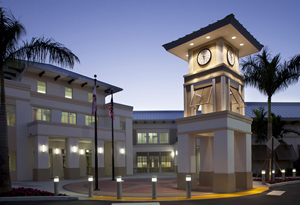Wellington is planning to scrap its entire land development code and adopt a completely revised version. On Wednesday, Wellington’s Planning, Zoning & Adjustment Board was given an assignment to help village staff with the task.
Planning & Zoning Manager David Flinchum explained that when Wellington incorporated, it adopted Palm Beach County’s set of land development codes, some of which did not apply or were inappropriate for the new municipality. Many of the uses and regulations are now obsolete.
As background, Flinchum said that he and Growth Management Director Robert Basehart have worked together in various capacities, starting in 1980 when Basehart hired him at his first job with the county’s planning division.
“He and I worked together for many years, and then we both went to the private sector, then I went back to the county, and then he and I ended up here in Wellington,” Flinchum said. “We’ll probably finish up our careers out here.”
That provides them both with a unique perspective.
“The reason that that’s both important and ironic is that both Bob and I are familiar with the original Wellington code, the evolvement from the Palm Beach County code that became the template of the Wellington code, the various text amendments over the years, and some of the tailoring that was done here in Wellington,” Flinchum said.
He noted that the village is now 95 percent built out and that large portions of the code are now antiquated, with land uses that will never be used.
“We have use types that will never be out here,” he said. “We’re at the point now where we need to face the fact that most of the codes are for vacant new proposals. We’re getting ready to go into a knock-down, rebuild, redevelopment mode pretty quickly, and we want to have regulations in effect that encourage those type of investments here in Wellington.”
Flinchum said that he has been tasked with revising the code, and he plans a dramatic overhaul.
“The code now is about 800 pages, and we’re going to cut that in about half,” he said. “The way we can do that is to remove a lot of the uses, remove a lot of the regulations, and focus on what we really need to work with from now on.”
Flinchum said most codes are set up like a matrix, with use types along the left side and zoning categories across the top.
“Within that grid system, you have rows and columns,” he said. “Where they meet, typically, is the procedural requirement for that use type to get a review and approval.”
Flinchum handed out a list of residential and commercial use types to board members for them to assign whether they felt the procedure should be permitted, go through the Development Review Committee, be a conditional use or require a special permit.
“It gives me some good feedback, your perspective of uses here in Wellington,” he said. “You’ve got to realize that a lot of the approvals were in place when you came out here, so you may assume that a movie theater is there by rights in a lot of shopping centers. You may assume that medical offices and veterinarians are allowed by rights, and a daycare is allowed by rights. Very often, some of these activities have been here for 30 years and have a zoning history. Sometimes they were controversial, and sometimes they weren’t.”
Flinchum said attitudes have changed toward some uses, such as cell towers.
“Cell towers, 20 years ago [people] would have filled this room,” he said. “With the hurricanes, people’s dependency on cell phones, trying to talk to their kids, it’s now part of the infrastructure. It’s an assumed, necessary service that people expect.”
Flinchum pointed out that a lot of uses over the years are not as controversial as they used to be.
“They are more accepted,” he said. “People actually like having certain services available in their immediate area, so we’re trying to get over that stereotype in most of the zoning codes.”
Flinchum said that was the purpose of the current exercise, to get a feel for board members’ perceptions toward certain uses.
He explained that permitted uses can get approval at the staff level. A DRC approval is a staff-level process that involves more departments, as well as public safety agencies. Conditional uses go through the PZA board and in some cases the Equestrian Preserve Committee.
There are two types of special permits. “Mostly, they’re administrative, staff-level approvals,” Flinchum said. “It’s for uses not typically in that area, and certain conditions may be needed. Some of your seasonal uses, like your Christmas trees, your fireworks, certain vendors — those are all special permits.”
Under that same category are seasonal equestrian permits that can go on for several months, and the intensity and traffic, spectators, noise and light issues all come into play.
“What we’re trying to do is simplify the code as much as possible,” Flinchum said, explaining that Wellington uses three different types of matrixes, one for straight zoning, one for planned developments and a third for the equestrian area.
“We’re trying to combine both the straight zoning and the planned development zoning,” Flinchum said. “When you come back over the next couple of months, you will be addressing those issues.”









Do not want a cell phone in my residential area. Staff should identify spots where a cell tower could go. No one wants a community littered with these eyesores. How about in Section 24, 34?
Now you wake up ,you should have been there when the meetings were held. Since you did not get involved don’t complain.